Hyundai Terracan 2004 Owner's Manual
Manufacturer: HYUNDAI, Model Year: 2004, Model line: Terracan, Model: Hyundai Terracan 2004Pages: 361, PDF Size: 4.69 MB
Page 281 of 361
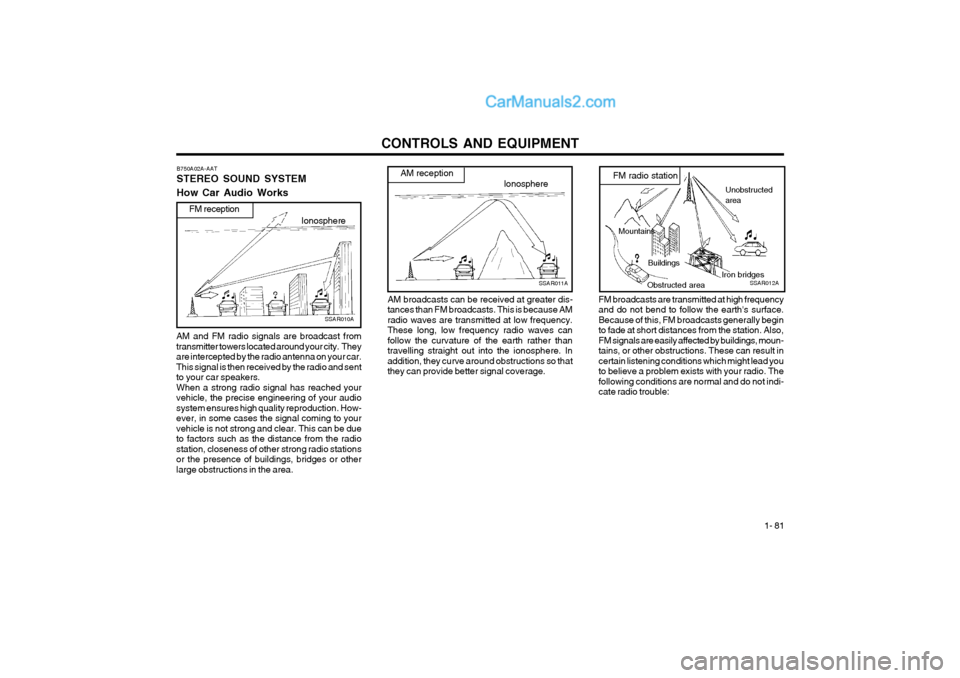
CONTROLS AND EQUIPMENT1- 81
FM broadcasts are transmitted at high frequency and do not bend to follow the earth's surface.Because of this, FM broadcasts generally beginto fade at short distances from the station. Also,FM signals are easily affected by buildings, moun-tains, or other obstructions. These can result incertain listening conditions which might lead youto believe a problem exists with your radio. Thefollowing conditions are normal and do not indi-cate radio trouble:
Mountains
Buildings
Obstructed area
Unobstructed area
FM radio station
SSAR012A
Iron bridges
Ionosphere
SSAR011A
AM reception
AM broadcasts can be received at greater dis- tances than FM broadcasts. This is because AMradio waves are transmitted at low frequency.These long, low frequency radio waves canfollow the curvature of the earth rather thantravelling straight out into the ionosphere. Inaddition, they curve around obstructions so thatthey can provide better signal coverage.
B750A02A-AAT STEREO SOUND SYSTEM How Car Audio Works
Ionosphere
FM reception
SSAR010A
AM and FM radio signals are broadcast from transmitter towers located around your city. Theyare intercepted by the radio antenna on your car.This signal is then received by the radio and sentto your car speakers.When a strong radio signal has reached yourvehicle, the precise engineering of your audiosystem ensures high quality reproduction. How-ever, in some cases the signal coming to yourvehicle is not strong and clear. This can be dueto factors such as the distance from the radiostation, closeness of other strong radio stationsor the presence of buildings, bridges or otherlarge obstructions in the area.
Page 282 of 361
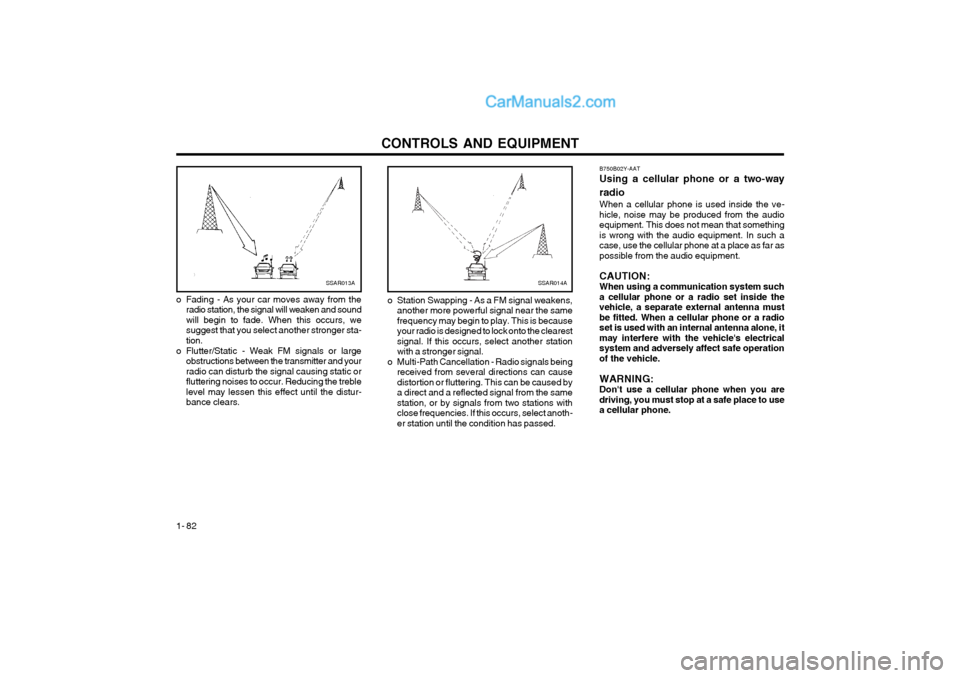
CONTROLS AND EQUIPMENT
1- 82 B750B02Y-AAT Using a cellular phone or a two-way radio When a cellular phone is used inside the ve- hicle, noise may be produced from the audioequipment. This does not mean that somethingis wrong with the audio equipment. In such acase, use the cellular phone at a place as far aspossible from the audio equipment. CAUTION: When using a communication system sucha cellular phone or a radio set inside thevehicle, a separate external antenna mustbe fitted. When a cellular phone or a radioset is used with an internal antenna alone, itmay interfere with the vehicle's electricalsystem and adversely affect safe operationof the vehicle. WARNING: Don't use a cellular phone when you aredriving, you must stop at a safe place to usea cellular phone.
SSAR014A
o Station Swapping - As a FM signal weakens, another more powerful signal near the same frequency may begin to play. This is becauseyour radio is designed to lock onto the clearestsignal. If this occurs, select another stationwith a stronger signal.
o Multi-Path Cancellation - Radio signals being received from several directions can causedistortion or fluttering. This can be caused bya direct and a reflected signal from the samestation, or by signals from two stations withclose frequencies. If this occurs, select anoth-er station until the condition has passed.SSAR013A
o Fading - As your car moves away from the radio station, the signal will weaken and sound will begin to fade. When this occurs, wesuggest that you select another stronger sta-tion.
o Flutter/Static - Weak FM signals or large obstructions between the transmitter and yourradio can disturb the signal causing static orfluttering noises to occur. Reducing the treblelevel may lessen this effect until the distur-bance clears.
Page 283 of 361
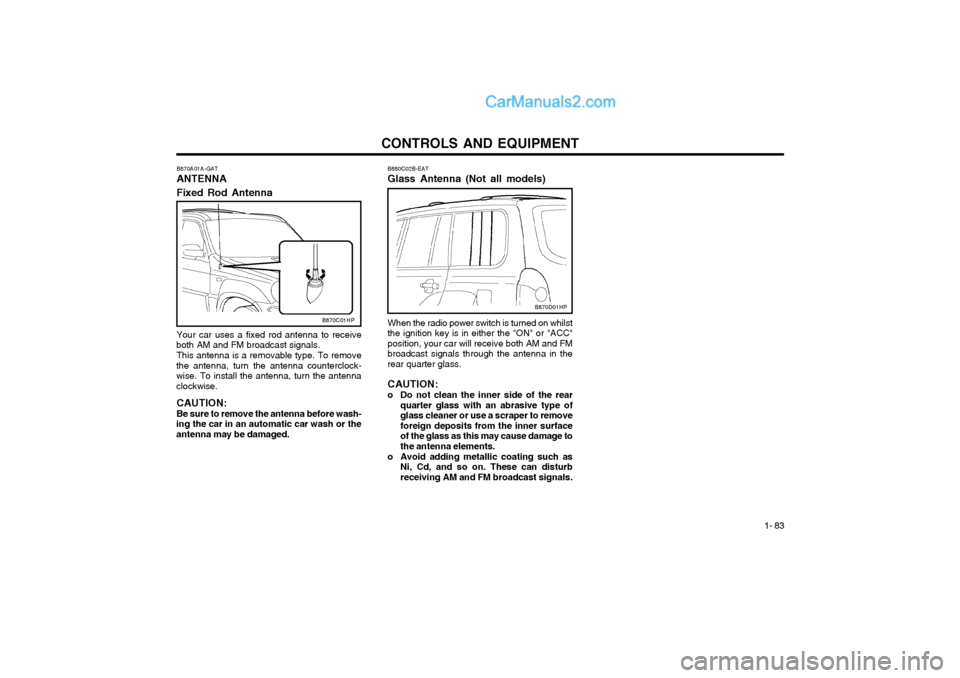
CONTROLS AND EQUIPMENT1- 83
B880C02B-EAT Glass Antenna (Not all models) When the radio power switch is turned on whilst the ignition key is in either the "ON" or "ACC"position, your car will receive both AM and FMbroadcast signals through the antenna in therear quarter glass. CAUTION:
o Do not clean the inner side of the rear quarter glass with an abrasive type of glass cleaner or use a scraper to removeforeign deposits from the inner surfaceof the glass as this may cause damage tothe antenna elements.
o Avoid adding metallic coating such as Ni, Cd, and so on. These can disturbreceiving AM and FM broadcast signals.
B870C01HP
B870A01A-GAT ANTENNA Fixed Rod Antenna Your car uses a fixed rod antenna to receive
both AM and FM broadcast signals.
This antenna is a removable type. To remove
the antenna, turn the antenna counterclock- wise. To install the antenna, turn the antennaclockwise.
CAUTION: Be sure to remove the antenna before wash-
ing the car in an automatic car wash or the antenna may be damaged.
B870D01HP
Page 284 of 361
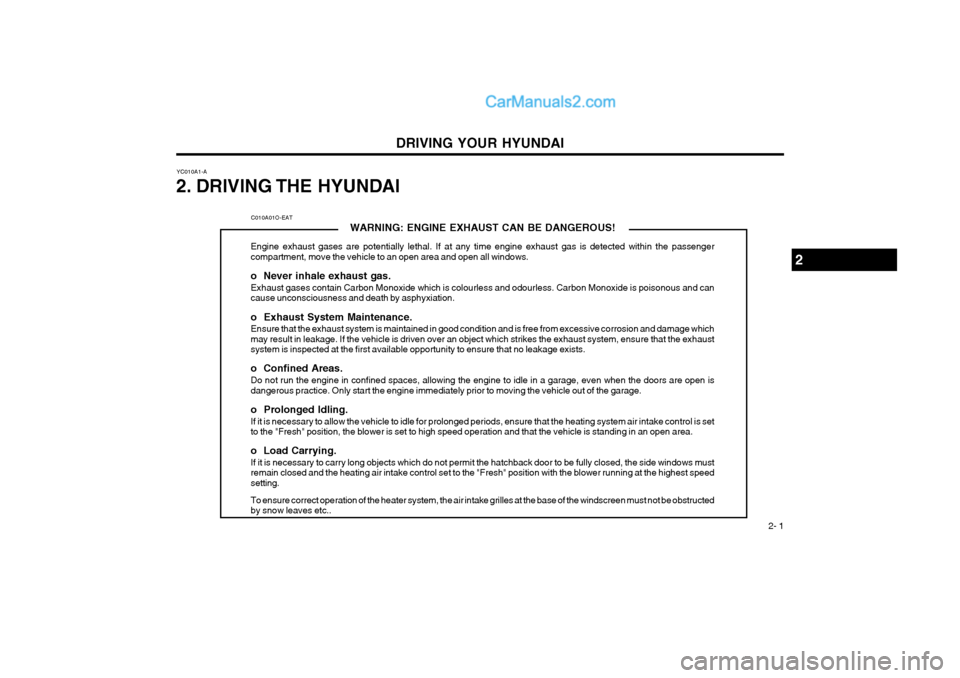
DRIVING YOUR HYUNDAI 2- 1
YC010A1-A
2. DRIVING THE HYUNDAI
C010A01O-EAT WARNING: ENGINE EXHAUST CAN BE DANGEROUS!
Engine exhaust gases are potentially lethal. If at any time engine exhaust gas is detected within the passenger compartment, move the vehicle to an open area and open all windows. o Never inhale exhaust gas. Exhaust gases contain Carbon Monoxide which is colourless and odourless. Carbon Monoxide is poisonous and can cause unconsciousness and death by asphyxiation. o Exhaust System Maintenance. Ensure that the exhaust system is maintained in good condition and is free from excessive corrosion and damage which may result in leakage. If the vehicle is driven over an object which strikes the exhaust system, ensure that the exhaustsystem is inspected at the first available opportunity to ensure that no leakage exists. o Confined Areas. Do not run the engine in confined spaces, allowing the engine to idle in a garage, even when the doors are open is dangerous practice. Only start the engine immediately prior to moving the vehicle out of the garage. o Prolonged Idling. If it is necessary to allow the vehicle to idle for prolonged periods, ensure that the heating system air intake control is set to the "Fresh" position, the blower is set to high speed operation and that the vehicle is standing in an open area. o Load Carrying. If it is necessary to carry long objects which do not permit the hatchback door to be fully closed, the side windows must remain closed and the heating air intake control set to the "Fresh" position with the blower running at the highest speedsetting. To ensure correct operation of the heater system, the air intake grilles at the base of the windscreen must not be obstructed by snow leaves etc..
2
Page 285 of 361

DRIVING YOUR HYUNDAI
2- 2 C020A01A-EAT
BEFORE STARTING THE ENGINE
Before you start the engine, you should always:
1. Look around the vehicle to be sure there are no flat tyres, puddles of oil or water or other indications of possible trouble.
2. After entering the car, check to be sure the parking brake is engaged.
3. Check that all windows, and lights are clean.
4. Check that the interior and exterior mirrors are clean and in position.
5. Check your seat, seatback and headrest to be sure they are in their proper positions.
6. Close all the doors.
7. Fasten your seat belt and be sure that all other occupants have fastened theirs.
8. Turn off all lights and accessories that are not needed.
9. When you turn the ignition switch to "ON" check that all appropriate warning lights are operating and that you have sufficient fuel.
10.Check the operation of warning lights and all bulbs when key is in the "ON" position. C030A01HP-EAT COMBINATION IGNITION SWITCH AND STEERING LOCK To Start the Engine
o If your Hyundai is equipped with a manual
transmission, place the shift lever in neutral and depress the clutch pedal fully.
o If your Hyundai has an automatic transmis- sion, place the shift lever in "P" (park).
o To start the engine, insert the ignition key and turn it to the "START" position. Releaseit as soon as the engine starts. Do not holdthe key in the "START" position for morethat 15 seconds.
NOTE: For safety, the engine will not start if the shift lever is not in "P" or "N" position(Automatic Transmission). SC050A1-E
KEY POSITIONS WARNING:
The engine must never be turned off and the key removed from the ignition key cylinderwhilst the vehicle is in motion since thesteering lock will operate and control of thevehicle will be lost.
C040A01E
LOCK
ACC
ON
START
WARNING: (Diesel only) To ensure that sufficient vacuum exists with-
in the brake system during cold weatherstart-up conditions, it is necessary to runthe engine at idle after starting according tothe following table.
Ambient temp.
Above 5°F (-15°C) Below 5°F (-15°C)Warm up time
3 min. or longer 6 min. or longer After starting the engine, do not drive the vehicle until the brake vacuum warning lighthas turned off. Failure to carry out the above procedure may result in the need to apply greater pedalpressure in order to effect the necessarybraking effort.
Page 286 of 361

DRIVING YOUR HYUNDAI 2- 3
YC030A1-E
STEERING WHEEL LOCK
When the ignition key is removed, the steering
wheel lock will be activated. The lock only engages at one position of the steering wheeland therefore it will be possible to turn the wheeluntil this position is reached. It is not, however,necessary for the lock to be engaged beforeleaving the vehicle since in the event of at-tempted unauthorized removal, the lock willengage when attempts are made to steer thevehicle.
Should it be difficult to turn the key from the
"LOCK" position, it may be found that rockingthe steering wheel to and fro whilst turning thekey will assist.
CAUTION: Never remove the key from the ignition lock
whilst the vehicle is in motion since the steering mechanism lock will be activated.
"START"
The engine is started in this position. It will
crank until you release the key.
NOTE: Do not hold the key in the "START" position
for more than 15 seconds. "ON"
When the key is at the "ON" position, the
ignition and all accessories are available for use. If the engine is not running, the key shouldnot be left at this position since the battery willbecome discharged and damage to the ignitionsystem may also result. For information regard-ing engine starting, refer to "STARTING THEENGINE". "ACC"
When the ignition key is at the "ACC" position,
the radio and other accessories may be used."LOCK"
The ignition key may only be inserted or re-
moved at this position.
NOTE: The ignition key can only be removed if the
transmission selector is at the "P" position (automatic transmission only). C070C01A-AAT
To Remove the Ignition Key
1. Turn the ignition key to the "ACC" position.
2. Simultaneously push and turn the ignition key counterclockwise from the "ACC" posi- tion to the "LOCK" position.
3. The key can be removed in the "LOCK" position.
C070C01E
LOCK
ACC
ON
START
Page 287 of 361
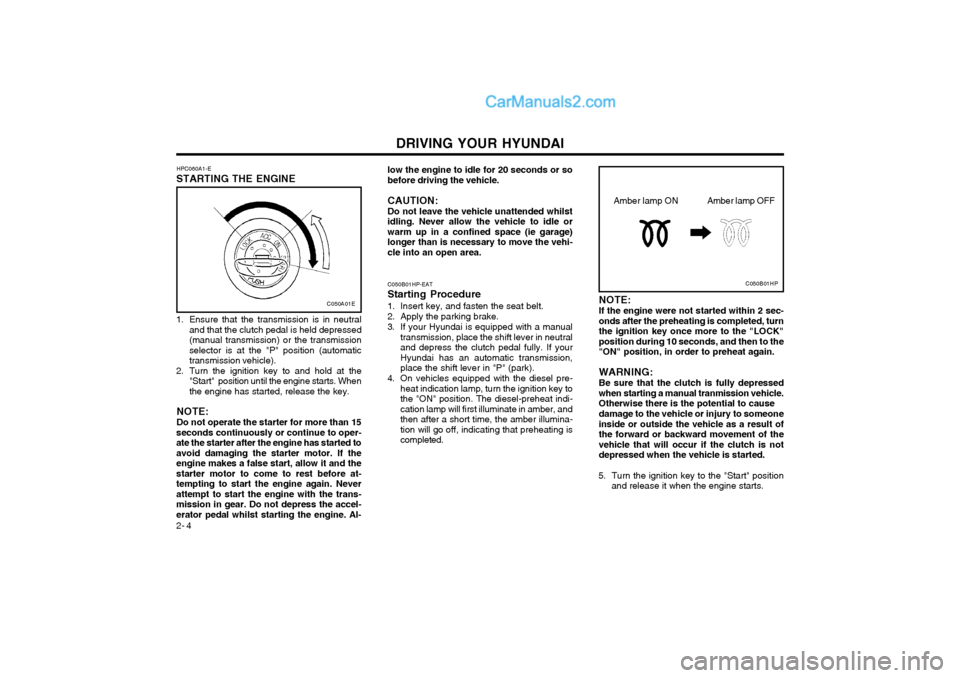
DRIVING YOUR HYUNDAI
2- 4 low the engine to idle for 20 seconds or so before driving the vehicle. CAUTION: Do not leave the vehicle unattended whilst idling. Never allow the vehicle to idle orwarm up in a confined space (ie garage)longer than is necessary to move the vehi-cle into an open area.
HPC060A1-E
STARTING THE ENGINE
1. Ensure that the transmission is in neutral and that the clutch pedal is held depressed (manual transmission) or the transmissionselector is at the "P" position (automatictransmission vehicle).
2. Turn the ignition key to and hold at the "Start" position until the engine starts. Whenthe engine has started, release the key.
NOTE: Do not operate the starter for more than 15
seconds continuously or continue to oper- ate the starter after the engine has started toavoid damaging the starter motor. If theengine makes a false start, allow it and thestarter motor to come to rest before at-tempting to start the engine again. Neverattempt to start the engine with the trans-mission in gear. Do not depress the accel-erator pedal whilst starting the engine. Al-
C050A01E
C050B01HP-EAT
Starting Procedure
1. Insert key, and fasten the seat belt.
2. Apply the parking brake.
3. If your Hyundai is equipped with a manual transmission, place the shift lever in neutral and depress the clutch pedal fully. If yourHyundai has an automatic transmission,place the shift lever in "P" (park).
4. On vehicles equipped with the diesel pre- heat indication lamp, turn the ignition key tothe "ON" position. The diesel-preheat indi-cation lamp will first illuminate in amber, andthen after a short time, the amber illumina-tion will go off, indicating that preheating iscompleted.C050B01HP
Amber lamp OFF
Amber lamp ON
NOTE: If the engine were not started within 2 sec- onds after the preheating is completed, turnthe ignition key once more to the "LOCK"position during 10 seconds, and then to the"ON" position, in order to preheat again. WARNING: Be sure that the clutch is fully depressed when starting a manual tranmission vehicle.Otherwise there is the potential to cause damage to the vehicle or injury to someone inside or outside the vehicle as a result ofthe forward or backward movement of thevehicle that will occur if the clutch is notdepressed when the vehicle is started.
5. Turn the ignition key to the "Start" position and release it when the engine starts.
Page 288 of 361
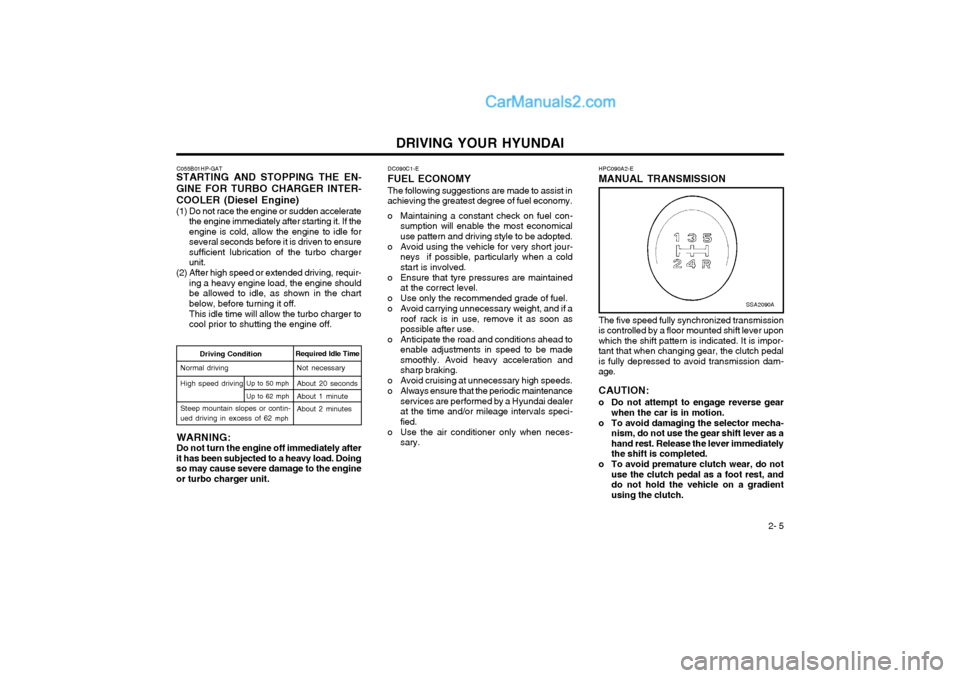
DRIVING YOUR HYUNDAI 2- 5
DC090C1-E
FUEL ECONOMY
The following suggestions are made to assist in
achieving the greatest degree of fuel economy.
o Maintaining a constant check on fuel con- sumption will enable the most economical use pattern and driving style to be adopted.
o Avoid using the vehicle for very short jour- neys if possible, particularly when a coldstart is involved.
o Ensure that tyre pressures are maintained at the correct level.
o Use only the recommended grade of fuel.
o Avoid carrying unnecessary weight, and if a roof rack is in use, remove it as soon as possible after use.
o Anticipate the road and conditions ahead to enable adjustments in speed to be madesmoothly. Avoid heavy acceleration andsharp braking.
o Avoid cruising at unnecessary high speeds.
o Always ensure that the periodic maintenance services are performed by a Hyundai dealer at the time and/or mileage intervals speci-fied.
o Use the air conditioner only when neces- sary. HPC090A2-E MANUAL TRANSMISSION
The five speed fully synchronized transmission
is controlled by a floor mounted shift lever upon which the shift pattern is indicated. It is impor-tant that when changing gear, the clutch pedalis fully depressed to avoid transmission dam-age. CAUTION:
o Do not attempt to engage reverse gear when the car is in motion.
o To avoid damaging the selector mecha- nism, do not use the gear shift lever as a hand rest. Release the lever immediatelythe shift is completed.
o To avoid premature clutch wear, do not use the clutch pedal as a foot rest, anddo not hold the vehicle on a gradientusing the clutch.
C055B01HP-GAT
STARTING AND STOPPING THE EN- GINE FOR TURBO CHARGER INTER- COOLER (Diesel Engine)
(1) Do not race the engine or sudden accelerate
the engine immediately after starting it. If the engine is cold, allow the engine to idle forseveral seconds before it is driven to ensuresufficient lubrication of the turbo chargerunit.
(2) After high speed or extended driving, requir- ing a heavy engine load, the engine shouldbe allowed to idle, as shown in the chartbelow, before turning it off. This idle time will allow the turbo charger to cool prior to shutting the engine off.
Required Idle Time
High speed driving Driving Condition
Normal drivingNot necessary About 20 seconds About 1 minute
Up to 62 mph
Up to 50 mph
Steep mountain slopes or contin-
ued driving in excess of 62 mphAbout 2 minutes
WARNING: Do not turn the engine off immediately after
it has been subjected to a heavy load. Doingso may cause severe damage to the engineor turbo charger unit.
SSA2090A
Page 289 of 361
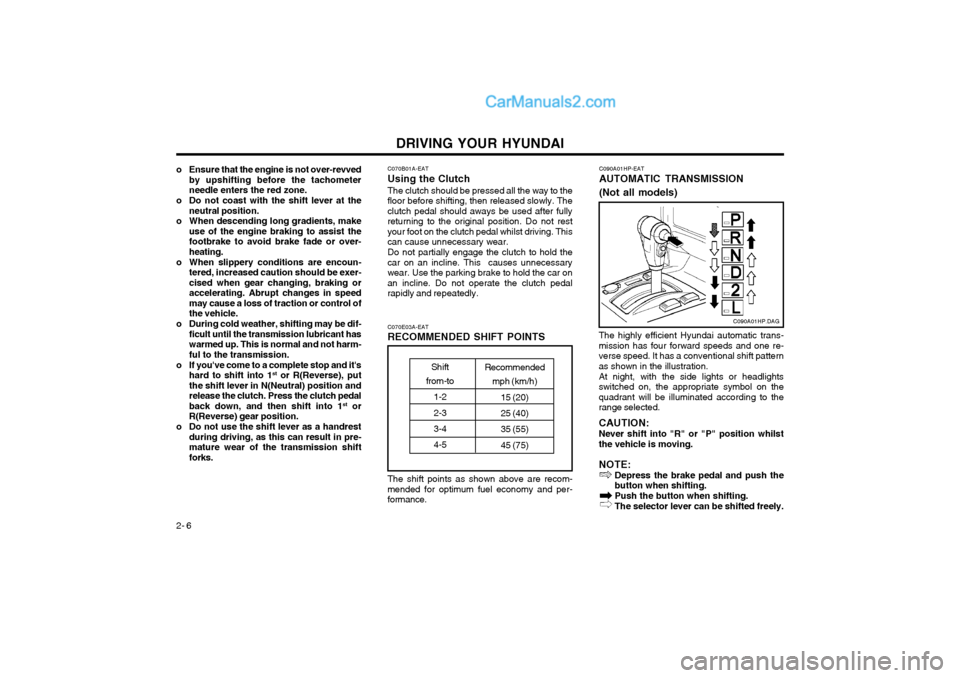
DRIVING YOUR HYUNDAI
2- 6
o Ensure that the engine is not over-revved
by upshifting before the tachometer needle enters the red zone.
o Do not coast with the shift lever at the neutral position.
o When descending long gradients, make use of the engine braking to assist thefootbrake to avoid brake fade or over-heating.
o When slippery conditions are encoun- tered, increased caution should be exer-cised when gear changing, braking oraccelerating. Abrupt changes in speedmay cause a loss of traction or control ofthe vehicle.
o During cold weather, shifting may be dif- ficult until the transmission lubricant haswarmed up. This is normal and not harm-ful to the transmission.
o If you've come to a complete stop and it's hard to shift into 1 st
or R(Reverse), put
the shift lever in N(Neutral) position andrelease the clutch. Press the clutch pedalback down, and then shift into 1 st
or
R(Reverse) gear position.
o Do not use the shift lever as a handrest during driving, as this can result in pre-mature wear of the transmission shiftforks. C070B01A-EAT
Using the Clutch
The clutch should be pressed all the way to the
floor before shifting, then released slowly. Theclutch pedal should aways be used after fullyreturning to the original position. Do not restyour foot on the clutch pedal whilst driving. Thiscan cause unnecessary wear.
Do not partially engage the clutch to hold the
car on an incline. This causes unnecessarywear. Use the parking brake to hold the car onan incline. Do not operate the clutch pedalrapidly and repeatedly.
The shift points as shown above are recom-
mended for optimum fuel economy and per-formance. C070E03A-EAT
RECOMMENDED SHIFT POINTS
Shift
from-to
1-2 2-33-4 4-5 Recommended
mph (km/h)
15 (20)25 (40) 35 (55)45 (75)
The highly efficient Hyundai automatic trans- mission has four forward speeds and one re-verse speed. It has a conventional shift patternas shown in the illustration. At night, with the side lights or headlights switched on, the appropriate symbol on thequadrant will be illuminated according to therange selected. CAUTION: Never shift into "R" or "P" position whilst the vehicle is moving. NOTE: Depress the brake pedal and push the button when shifting. Push the button when shifting. The selector lever can be shifted freely.
C090A01HP-EAT
AUTOMATIC TRANSMISSION (Not all models)
C090A01HP.DAG
Page 290 of 361
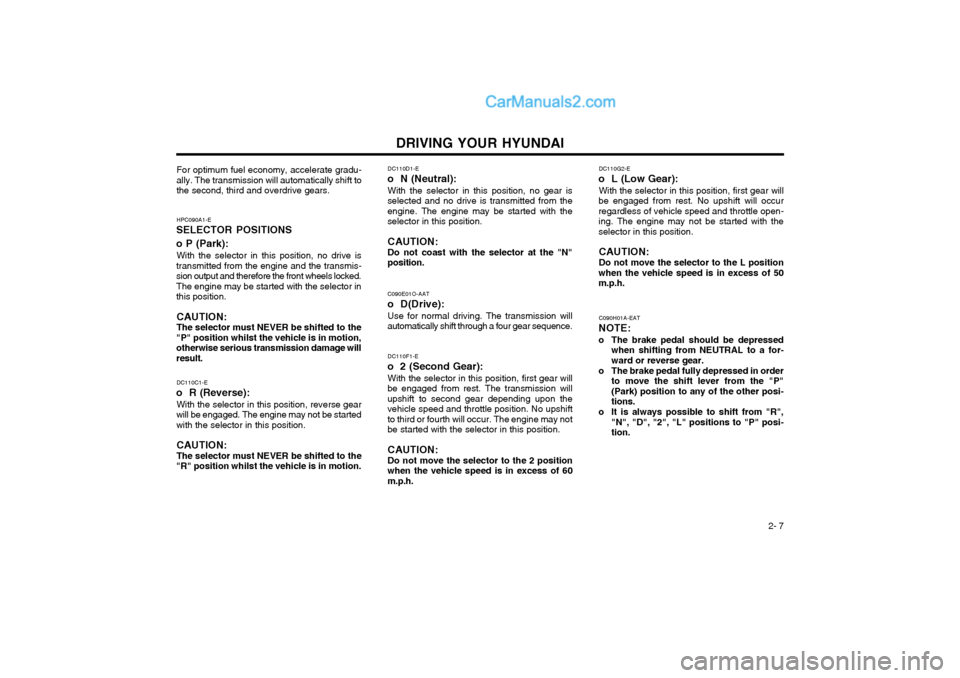
DRIVING YOUR HYUNDAI 2- 7
DC110D1-E
o N (Neutral):
With the selector in this position, no gear is
selected and no drive is transmitted from the engine. The engine may be started with theselector in this position.
CAUTION: Do not coast with the selector at the "N"
position.
DC110C1-E
o R (Reverse):
With the selector in this position, reverse gear
will be engaged. The engine may not be started with the selector in this position.
CAUTION:The selector must NEVER be shifted to the
"R" position whilst the vehicle is in motion. HPC090A1-E
SELECTOR POSITIONS o P (Park): With the selector in this position, no drive is
transmitted from the engine and the transmis- sion output and therefore the front wheels locked.The engine may be started with the selector inthis position.
CAUTION:The selector must NEVER be shifted to the
"P" position whilst the vehicle is in motion,otherwise serious transmission damage willresult. C090E01O-AAT
o D(Drive): Use for normal driving. The transmission will
automatically shift through a four gear sequence.
For optimum fuel economy, accelerate gradu-ally. The transmission will automatically shift tothe second, third and overdrive gears.
C090H01A-EAT
NOTE:
o The brake pedal should be depressed when shifting from NEUTRAL to a for- ward or reverse gear.
o The brake pedal fully depressed in order to move the shift lever from the "P"(Park) position to any of the other posi-tions.
o It is always possible to shift from "R", "N", "D", "2", "L" positions to "P" posi-tion.
DC110F1-E
o 2 (Second Gear):
With the selector in this position, first gear will
be engaged from rest. The transmission willupshift to second gear depending upon thevehicle speed and throttle position. No upshiftto third or fourth will occur. The engine may notbe started with the selector in this position.
CAUTION: Do not move the selector to the 2 position
when the vehicle speed is in excess of 60 m.p.h. DC110G2-E
o L (Low Gear):
With the selector in this position, first gear will
be engaged from rest. No upshift will occurregardless of vehicle speed and throttle open-ing. The engine may not be started with theselector in this position.
CAUTION: Do not move the selector to the L position
when the vehicle speed is in excess of 50 m.p.h.